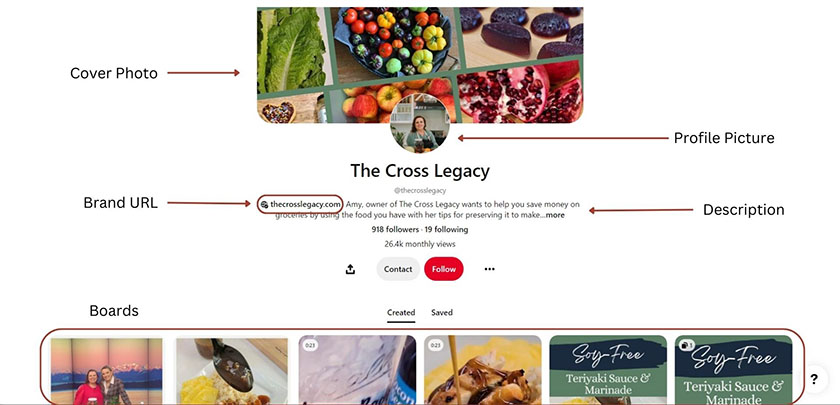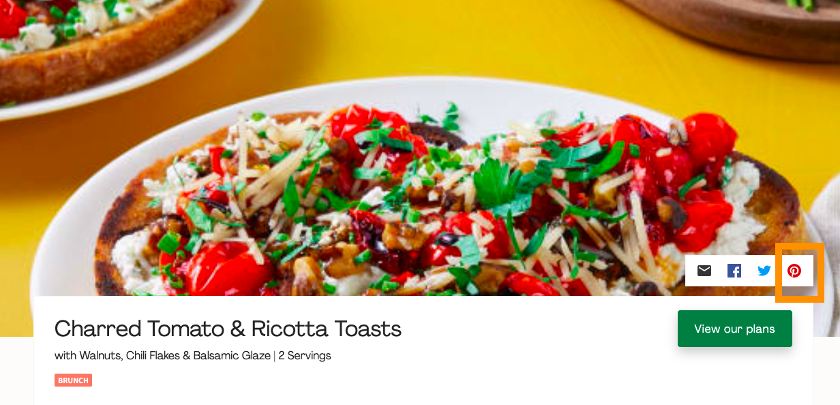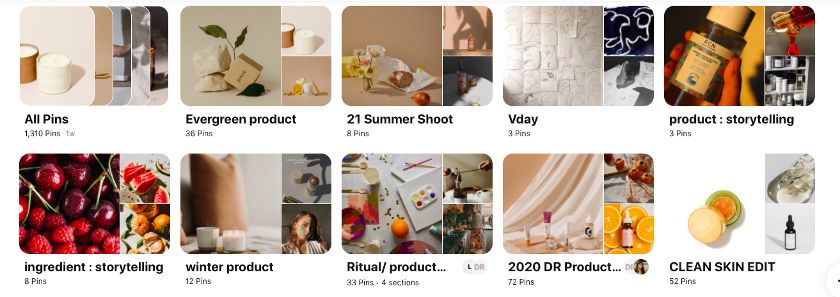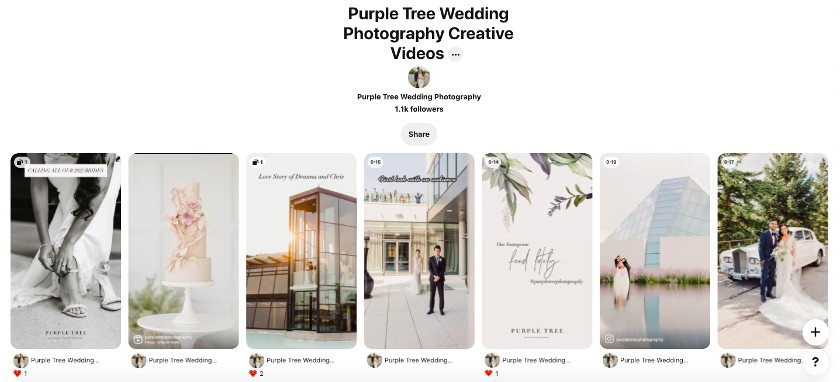Effective Pinterest marketing allows small businesses to reach target audience members with visual content through free organic search, paid targeting, and storytelling features. Learn how to use Pinterest for business by following the steps below to showcase your brand, sell and display products, drive web traffic, and connect with potential customers.
Pinterest Marketing Basics for Small Businesses
Pinterest is as much a search engine as it is a social forum. It works by allowing users, or “pinners,” to post visual ideas and inspiration images and videos called “pins.” Pins are organized on the user’s board under a specific theme. Pinned images can then be searched for, saved, and clicked on by other users.
Below are some important Pinterest terms and associated meanings to understand:
- Pin: An image or video uploaded to Pinterest and saved to one or more user boards
- Repin: A re-post of a Pin by another user
- Pinner: An individual or business user who adds Pins
- Follow: When a user subscribes to another user’s profile or board
- Board: Collection of Pins on a specific topic or theme (e.g., “website color scheme ideas” or “vacation house plans”)
- Feed: Personalized main stream of Pins a user sees when they log into Pinterest
- Lens: A visual search feature on Pinterest that provides Pins similar to what a user captures with the lens camera
Having people click on their Pins can help drive traffic, leads, and sales for businesses. Web traffic generated through social media marketing boosts website search engine optimization, which, in turn, can positively impact rankings.
At the same time, having an online presence on Pinterest helps businesses build brand awareness and affinity with members of their target audiences. With that in mind, follow the steps below to use Pinterest to engage members of your target audience and market your products and services.
How to Use Pinterest to Promote Your Business
To use Pinterest for business, you must have a business account. Create a strategy dedicated to marketing with Pinterest, then roll out your content, optimizing and promoting them along the way. Follow these steps to get started:
1. Create a Pinterest Business Account
You can set up Pinterest for your business in two ways. Either you create a brand-new Pinterest for Business account or convert an existing personal account to a business profile.
Create a brand-new business profile if you don’t have a personal Pinterest account or if you want to have a separate account entirely for your business. Here is how to do it:
- Go to the Pinterest for Business page
- Click the “Sign Up” button on the upper-right corner of the page
- Fill out the necessary details about your business
- Click on the “Create Account” button
If you already have a Pinterest account registered to your business email, you can upgrade it to a business account for free.
- Log in to your personal profile
- Click the drop-down arrow icon on your page’s upper right-hand corner
- Select the “Convert to Business” option under the “Your Accounts” section
- You will be prompted to get a free business account; click on the “Upgrade” button to move forward
- Fill out your business information
2. Optimize Your Profile
Each element of your Pinterest profile is an opportunity to tell your customers about your brand. When users visit your profile, they should know what your brand is all about right off the bat.
Ensure your brand’s image is reflected in these elements:
- Profile picture: A square profile picture of at least 165 x 165 pixels. Use your company logo or an image that is distinct and recognizable to your brand, such as a professional headshot.
- Cover photo: A cover photo that is 800 x 450 pixels. Choose an eye-catching horizontal image that is true to your brand’s style.
- Description: A short yet meaningful description that defines your brand.
- Your brand’s URL: Make it easy for followers to visit your website or online store.
- Pinterest boards: Pins curated and organized in different categories.

Example of optimized Pinterest for Business profile (Source: The Cross Legacy)
3. Develop a Strategy for Promoting Your Business on Pinterest
Your content strategy is the blueprint for learning how to use Pinterest to promote your business. It should outline the types of content that will be shared on the platform, the frequency of posts, the target audience, and the goals for the presence on the platform.
You can develop a content strategy similar to how to make a social media plan. The factors to consider include business or marketing goals, target audience, competition, posting schedules, and the specific content you can create. To learn more about the steps of creating a content strategy, click through the drop-down items below to read more instructions.
Your goals will guide the type of content you create and how to interact with your audiences. Make sure you clearly define what success means to you early on. Here are some common goals when using Pinterest for business:
- Gaining followers
- Develop brand awareness
- Drive website traffic
- Increase sales
- Educate viewers
For example, if you want to educate your customers, create how-tos and recipes. If you want to convert followers into customers, add a link to your shop where they can purchase.
Understanding your target audience’s demographics, interests, and behaviors will help guide the content and tone of your Pinterest presence. Imagine your ideal customer and their characteristics to determine what types of content will resonate with them.
A useful tip to consider is to create a customer persona. This is a tool that helps define your company’s ideal buyer types. Check out our article on how to create a customer persona. Not only does it break down how to do it, but it also comes with a free downloadable template.
If you’re just starting with marketing on Pinterest, chances are there is already some competition on the platform. Don’t worry, you can use this to your advantage.
Look at other brands and influencers in your industry to see what types of content they are posting on Pinterest. Take note of what is working well for them and consider how you can differentiate your approach.
A content calendar will help you plan and organize your content on Pinterest. To create a content calendar, decide on your posting frequency and the type of content you will post.
You can do this by starting with a list of content themes that align with your target audience’s interests and the types of content you plan to create. For example, if you sell home decor, your themes might include DIY home projects, home organization, and seasonal decorating ideas.
Finally, use a tool or a basic spreadsheet to plan your content. Include the themes, types of content, and the date you plan to publish it. A good content calendar can be key in learning how to use Pinterest to promote your business.
4. Post Compelling Content
Pinterest is a visual platform, so it’s crucial to use high-quality images and videos for your Pins. In terms of how to use Pinterest to promote your business, there are a few standards that can better your chances of attracting potential customers. Create each Pin with these in mind:
- Standard Pin: Use a vertical image (2:3 aspect ratio). You can add your logo to a Pin but keep it subtle. The image itself should represent your branding. You can add a text overlay in the image but keep it short and readable on mobile.
- Video Pin: Organic videos should be between 15 and 60 seconds long, while video ads should be six to 15 seconds long. The first few seconds must capture your audience’s attention right away. The cover image must be eye-catching and able to convey what your content is about at first glance. Use text overlay or captions when needed.
- Pin descriptions: When creating descriptions, keep in mind how your audience would search for your content. Include relevant keywords that users might type into a search and accurate descriptions. Keep it to no more than 100 characters for titles and up to 500 characters for descriptions.
- Pin links: Make sure your links work and direct your audience to information on your website that matches the Pin they just saw.
On Pinterest, you are competing with other brands producing visual content. Pins that are color-coordinated and in high definition perform well. Inspirational images, educational Pins, and infographics are the content formats Pinterest users like to engage with. In fact, 85% of Pinterest users go to the platform when starting a new project.
Most importantly, showcase your brand’s look and personality. Create boards that tell your brand story in a cohesive, appealing way. Consider working with a graphic designer to create eye-catching visuals that stand out in the Pinterest feed.
Want high-quality images but don’t have the budget for a designer just yet? Try out one of Canva’s top Pinterest Pin templates for free or start from scratch to create your perfect design.
5. Promote Your Content
Using Pinterest advertising in the form of promoted Pins or shopping ads can help your business reach a wider audience and drive conversions. At the same time, don’t be afraid to share your Pins on other social media platforms and in email campaigns. This helps drive engagement and increases visibility.
Promote Your Business With Pinterest Ads
In addition to learning how to use Pinterest for business marketing, you can maximize Pinterest marketing efforts by advertising on Pinterest. There are three primary objectives to consider when using Pinterest ads as part of your overall social media advertising plan: creating brand awareness, boosting engagement, and driving traffic to your website.
Let’s look at how pricing for these objectives work:
- Brand awareness: Use Pinterest to introduce your brand to people who don’t know about it yet. Ad costs for reach are based on the CPM, or cost-per-mille (Latin for “thousand”) for impressions. The CPM for Pinterest ads is $2 to $5 dollars for every 1,000 impressions.
- Boost engagement: If you want people to interact with your Pins, you can pay to boost engagement. Users engage by clicking on your Pins or repining them. Based on the average cost-per-engagement (CPE) for this type of ad, expect to pay 10 cents to $1.50 per engagement.
- Drive web traffic: You use Pinterest ads to drive traffic to your website. You pay for the CPC (cost-per-click) for this type of ad. The CPC for Pinterest ads is between $0.10 and $1.50 per click.
Aside from demographic segments like age, gender, and location, you can segment your audience by people who have visited your site, users who interact with your Pins, or those with similar interests to your content. You can also create lookalike audiences with similar behaviors to segments you already have.
Pinterest User Demographics
Any marketing campaign can only succeed if it reaches the business’ target audience. These Pinterest user demographics can help you gauge whether or not the people you are trying to reach are on Pinterest.
Here’s an overview of Pinterest user demographics that might show it’s a good social media platform for your business:
- In Pinterest’s Investor Earnings Report for Q4 2022, Pinterest announced that it has 450 million monthly active users.
- Statista reported that in January 2023, 76.2% of Pinterest users were female, 17.2% male, and 6.6% unspecified.
- 31% of adults in the U.S. use Pinterest, making the U.S. the country with the most extensive advertising opportunities for small businesses.
- People 50 to 64 years old make up the biggest age group on Pinterest (38%).
- Users with an annual household income of $75,000-plus make up the biggest percentage of Pinterest users (40%).
Who Pinterest Marketing Is Best For
Pinterest is known as an effective social media marketing platform for ecommerce businesses. It’s also a great site for any business wanting to reach people who are likely to seek visual inspiration in general. For example, an interior designer or furnishings store can use Pinterest to reach users looking for how to decorate a home office.
Restaurants and companies that sell kitchen appliances or cooking supplies can engage Pinterest users who are on the platform looking for recipes. Homebuilders and architects can reach people who are looking for dream home plans or specific features they want in a new home.
Plus, virtually any brand that wants to reach a female, higher-income audience can promote their business effectively on Pinterest. With a high user purchasing intent, Pinterest is a strong avenue for advertising products and services for lifestyle, fashion, and home organization.
Who Pinterest Isn’t a Good Fit For
Pinterest is not effective for marketing niche products or highly technical services. Since Pinterest is a visual platform, it is also not a good fit for businesses without any tangible products, like those selling software.
Sometimes, even if you have tangible products, assess whether or not you can market them in a visually appealing manner. For example, a local butcher shop may find it difficult to market on Pinterest, especially compared to the return they can get through local search engine optimization (SEO) strategies.
Pinterest Marketing & Advertising Tips
There’s more to running a successful Pinterest campaign than creating a business account and posting content. To maximize your time and grow your business more efficiently, follow these tips for business Pinterest:
1. Include Key Search Terms in Pin Descriptions
Pinterest users search for ideas and inspiration by typing keywords related to their interests and hobbies. Compared to a Facebook Business Page where users need to follow your brand to see your content on their feed, on Pinterest, they can see your content when they search for the keywords you are using.
To ensure your Pinterest content is searchable, include keywords and hashtags in your descriptions that people use when looking for content or products like yours. If you’re unsure what keywords to use, type a word into the Pinterest search bar. Underneath, you’ll see suggestions for related terms to include in your Pins’ titles and descriptions.
2. Create a Shop to Sell Directly on Pinterest
Aside from liking posts, Pinterest users utilize the platform to buy. According to Pinterest Media Agency Advertising Guide, 85% of weekly pinners purchase something based on Pins that they see from brands on Pinterest.
This opens up opportunities to not only increase online presence, but also generate sales through Pinterest. Setting up a Pinterest Shop tab allows merchants to upload an entire catalog of products for sale in a dedicated tab. It also makes it easy for users to find items for sale on Pinterest.
Here are four ways users can use the shop feature on Pinterest:
- Shop from search: When users search for specific keywords like “bento lunch box,” they can click on the shop results to show items they can buy. These are separated from Pins that contain bento box ideas or bento lunchbox post how-tos. The Pins from the Shop tab direct them to a checkout page where they can purchase the items they want in just a few clicks.
- Shop from a Pin: Users can click “shop similar items” on the bottom right corner of a Pin to see for sale items similar to the image they are looking at.
- Shop from boards: Users will see a Shop tab that shows products from or inspired by items on their boards.
- Shop from style guides: When users search for terms like “living room ideas,” they are also given the shop options to recreate the Pins.
3. Give People a Reason to Visit Your Website
Because you can use Pinterest as a search engine, choose the right keywords and eye-catching photos to encourage your audience to click through and visit your website. For example, placing text over an image to announce a special offer can entice users to visit your website to see more products on sale.
Even service-based businesses use Pinterest to generate leads and sales. For example, a Pin showcasing a “before and after” look gives users more information about a company’s home staging, landscaping, home renovation, or similar services.
4. Add Pinterest Save Buttons to Your Website
Adding Pinterest save buttons to images on your website makes it easy for people to pin your content. The save button helps users bookmark your products to their Pinterest boards and find your revisited products quickly.
Use the Pinterest Widget Builder to customize your save button. Place the save button on product images, infographics, and videos on your web pages so visitors can create Pins in a few clicks without leaving your site.

Pinterest save button on HelloFresh’s website (Source: HelloFresh)
5. Optimize Your Pins With Pinterest Trends Tool
The Pinterest Trends Tool lets you search for different terms and see how many people are searching for them. This is valuable for discovering how users search for you or your products.
For example, if you own a clothing business and are planning for a summer collection, you can search for “summer outfits.” Then, Pinterest Trends will show you the volume of searches this phrase had weekly over the last year.

Pinterest Trends shows the volume of searches over time for keywords. (Source: Pinterest Trends)
You can also use Pinterest Trends to see related trends and the most popular Pins based on your search term. This will help you optimize your Pin title and description with search terms your audience most likely use. Plus, knowing when interest is highest gives you a good idea of the best time to advertise your particular products or services on Pinterest.
6. Track Your Performance With Pinterest Analytics
Your Pinterest business account has in-app access to analytics on your organic and paid content. On Pinterest Analytics, you can see which types of content are performing well, what time your audiences are most active, and how much traffic your Pins drive to your website.
7. Use Apps to Streamline Posting & Performance Tracking
Marketing a small business on Pinterest is already time-consuming, especially if you’re creating top-notch content yourself. Using third-party apps to streamline your process can help you achieve more in a shorter amount of time, all while tracking your performance.
For example, platforms like Looka and Canva allow you to create content and post it directly on social media. Learn more about these apps, both of which are also on our list of the best sites for designing logos and other web graphics.
Other platforms, like Sprout Social and Later, allow you to create posts in advance and schedule them at a later time. This creates efficiencies that help you save time without having to go onto each platform every day to maintain activity. In addition, they offer a deeper look into metrics for reach and engagement so that you can tweak and improve your social marketing strategies over time.
Statistics Show the Benefits of Using Pinterest for Business
According to established marketing writer Tom Kotze, “Using Pinterest for ecommerce is something that many businesses don’t take full advantage of, but it can generate awesome results if you know the right strategies. Pinterest offers amazing opportunities to boost your marketing strategy, drive more brand awareness, and target a bigger audience.”
Check out these Pinterest statistics for businesses that show just how beneficial Pinterest can be:
- Pinterest boosts brand visibility: There are over 450 million active people who use Pinterest every month, making it one of the largest social networks to market on.
- Pinterest can help increase conversions: Pinterest users are three times more likely to click through to a retailer’s site from Pinterest than from other social media platforms.
- It is easy to showcase products on Pinterest: Pinterest is a visual platform ideal for showcasing products. Pinterest users spend 80% more in retail than people off Pinterest.
- Pinterest helps build brand loyalty: By consistently posting recognizable content that resonates with the audience, businesses find engaged followers on Pinterest. In fact, 77% of their users on Pinterest are loyal to the brand.
- Advertising on Pinterest is cost-effective: Ads on Pinterest have a 2.3 times lower cost per conversion than ads on other social media platforms.
Frequently Asked Questions (FAQs)
Yes. You can schedule Pins ahead of time using social media scheduling tools like Sprout Social, Hootsuite, Buffer, and others. Scheduling Pins will help you save time and plan your strategy.
Pinterest is an excellent platform for small businesses with its low cost, large and engaged audience, and analytics tools. It can serve as an entry point for social media marketing or be used with other networks for a powerful social media campaign.
It is free to create or upgrade to a Pinterest business account. Using their business features and analytics tools comes at no cost. However, like other social media networks, Pinterest offers paid advertising options with promoted Pins and shopping ads, with costs ranging from $2 to $5 or ad impressions from 10 cents to $1.50 for engagements and clicks.
Bottom Line
With 450 million active users discovering, saving, and sharing Pins, Pinterest can connect your business to your target audience. Learn how to use Pinterest for business in a few steps: create a Pinterest business account, plan, develop, and optimize your content for free. Take it to the next level by considering paid promotions.

